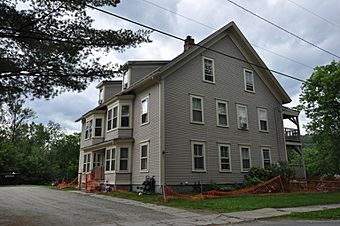Building at 143 Highland Avenue facts for kids
Quick facts for kids |
|
|
Building at 143 Highland Avenue
|
|
 |
|
| Location | 143 Highland Ave., Hardwick, Vermont |
|---|---|
| Area | less than one acre |
| Built | 1889 |
| Architectural style | Tenement |
| NRHP reference No. | 00000358 |
| Added to NRHP | April 6, 2000 |
143 Highland Avenue is an old apartment building in Hardwick, Vermont. It was built around 1889. This building was made to house workers. These workers were employed in the local granite quarries. It still shows many of the useful features typical for worker housing from that time. Because of its historical importance, it was added to the National Register of Historic Places in 2000.
Contents
What is 143 Highland Avenue Like?
143 Highland Avenue is in a neighborhood north of Hardwick's town center. It sits on the south side of Highland Avenue. This building is quite large, with two and a half stories. It is made of wood and has a pointed roof. The outside is covered with clapboard siding.
Building Design and Features
The front of the building faces east. It has a balanced look with five sections. The main entrance is in the middle. A small porch with a slanted roof covers the entrance. This porch connects two bay windows that stick out from the building. On the roof, there are two small dormer windows. The sides of the building have four sections each. The basement can be seen from the back and left side. This is because the ground slopes downwards.
Inside the Building
Inside, the first and second floors have identical apartment layouts. There is also an extra apartment in the attic. The basic design of the first and second floor apartments is original. However, some changes were made to add plumbing. Plumbing was not part of the building when it was first built. During its repair, old wooden details were kept as much as possible. An old back porch system was replaced. The new one looks more like what was there in early photos.
Why Was 143 Highland Avenue Built?
This building was constructed around 1889. At that time, many workers needed places to live in Hardwick. This was due to the growing granite industry. Unlike some other industrial towns, businesses in Hardwick did not build housing for their workers. Instead, local people built homes for them. This apartment building was likely built by J.J. Campbell. He bought the land and lived in a house across the street.



